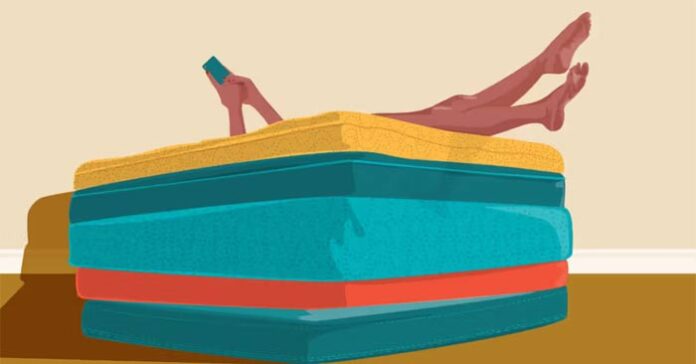Are Memory Foam Mattresses the Best Choice? Do Firm Mattresses Protect Your Back? Do You Really Need a Washable Cover? This article will answer these questions and more.

According to the National Bed Federation, the average lifespan of a mattress is around 6 years. That’s a lot of foam and springs being sent to landfills. But should you continue using an uncomfortable bed for the sake of the planet, or is there a wiser choice when it comes to mattress shopping?
The wiser choice is to opt for a new mattress, especially if you can find a retailer that will recycle your old one. A well-made mattress with the right balance of support and comfort for your size and sleeping position can truly transform your sleep quality. It can also alleviate aches and pains, help you sleep peacefully alongside your partner, and may even last longer than six years. But a good, durable mattress doesn’t come cheap.
Today’s mattresses come in various types, including the popular “bed-in-a-box” varieties that are delivered directly from the factory. You can’t try these mattresses before you buy, but they usually offer extended trial periods, so you can sleep on them for several months before deciding whether to keep them. This is arguably a better way to test a mattress than being the 200th person to jump on the display bed in a showroom.
This article will explore the pros and cons of different mattress types and reveal what to consider when choosing the perfect mattress for you.
How to Choose the Best Mattress
Mattress Types
Pocket Spring Mattresses
- Pros: Targeted support; more environmentally friendly than foam.
- Cons: Can be too bouncy if you share a bed; may sag over time.
You can buy cheap, open-coil spring mattresses with a single long wire, but if you’re after comfort, go for pocket spring. These mattresses contain hundreds or even thousands of strong, small springs, each sewn into their fabric pocket to isolate movement. This creates a firm yet bouncy foundation that supports and cushions you where needed. The isolation of each spring also helps absorb your partner’s movements, though not as effectively as foam.
Pocket spring mattresses are considered more environmentally friendly than foam or hybrid mattresses because their production often uses less plastic and incorporates more natural fibers. This construction also allows for better air circulation, helping you stay cool while you sleep.

Memory Foam Mattresses
- Pros: Balances comfort and orthopedic support; excellent motion isolation.
- Cons: Can retain heat and feel damp; requires adjustment time.
Some foam mattresses use regular poly foam, the type used for seat cushions and as a comfort layer over springs in pocket spring mattresses. Memory foam, however, is denser and more expensive, offering superior support—it can feel quite firm—as well as cushioning and pressure relief. It’s also excellent at absorbing movement.
The contouring nature of memory foam can make it feel soft and enveloping. Some people love this sensation, while others don’t, and it can lead to overheating. Another option is latex foam, which has natural breathability and hypoallergenic properties but is more expensive than regular memory foam.
Many all-foam mattresses contain multiple layers of different foams, including latex, various densities of memory foam, and other specialty foams. The only way to be sure you’ll like a foam mattress is to sleep on it for a while.
Hybrid Mattresses
- Pros: Best balance of cushioning, support, breathability, and motion isolation.
- Cons: Can be very expensive and heavy; many variations make it hard to choose the ideal product.
Combine pocket springs with memory foam, and you get a hybrid mattress. The combination of foam, springs, and other components varies between mattress models, with some premium options wrapping thousands of ultra-high springs in layers of latex foam, high-density memory foam, mesh foam, cooling foam infused with bamboo and natural wool, and more. Many models also add one or two layers of “micro springs” to increase comfort by allowing the mattress to conform to your body.
The idea of a hybrid mattress is to offer all the pros of springs and foam without the cons. However, there’s no such thing as a perfect mattress—only the perfect mattress for you. So, hybrids will differ in terms of firmness, cushioning, temperature control, and motion isolation.

Why a Firm Mattress Isn’t Always the Better Option
One person’s perfect mattress can be another’s backache. One reason why mattress advice often includes a lengthy trial period is that it can take a few nights, or even weeks, to assess how well a mattress’s firmness suits you.
However, there are a few ways to predict how you’ll like your new mattress. First, lie on your back and try to slide your hand under the small of your back. If there’s a big gap, the mattress surface is too firm. If there’s no gap at all, it’s too soft.
Now, lie on your side in your usual sleeping position and have someone take a photo. If you can draw a straight line from your spine to your knees, your spine is likely “aligned,” and the mattress suits you. If the line curves up or down, your spine isn’t straight, and you’ll likely feel uncomfortable.
The ideal mattress firmness depends on your natural sleeping position. If you mostly sleep on your side, you need extra cushioning for your hips, knees, and shoulders (pressure points). A very firm mattress won’t suit you, especially if you have muscle or joint issues like hip pain. If you sleep on your back or front, you can get away with a firmer surface.
However, no one benefits from an extremely firm or soft mattress. Simon Durrant, director of the Sleep Research Centre at the University of Lincoln, says, “If the mattress is too soft, you’ll find it almost impossible to maintain a good sleep posture.” “But if it’s too firm, it will cause uncomfortable pressure and lead to poor sleep and aches and pains, and you’ll end up waking up more often.”
Your body size also matters. Smaller bodies don’t sink into the cushioning as much as larger ones. If you’re petite, you need a little extra softness to feel comfortable; if you’re larger, you need a firmer surface to feel supported.
Regardless of your size, don’t skimp on bed size. Being able to stretch out on a bed improves sleep quality and reduces the risk of stiffness or pain—and if you share a bed, you’ll both appreciate the extra space.
Worthwhile Mattress Features
Size, firmness, and price are likely the main factors you’ll consider when choosing a mattress, but there are other features to keep in mind.
A warranty of 10 years or more is a good sign that the mattress is built to last. Most warranties will ensure that the mattress won’t sag significantly, have broken springs, or come apart at the seams within a decade—just be sure to follow the care instructions to avoid voiding the warranty.
All boxed mattresses come with trial periods during which you can return the mattress for any reason, provided you’ve cared for it by using a mattress protector.
A removable, washable cover is a must-have if your mattress has memory foam, which can retain heat. Most hybrid and high-quality foam mattresses have soft, fabric covers that you can unzip and machine wash at 40°C.
Another useful feature is a cooling layer, which helps counteract the warming effect of memory foam. No mattress can actively lower your body temperature—it’s not like storing your sheets in the fridge—but layers containing breathable materials like wool, bamboo, and charcoal can prevent overheating and help you sleep comfortably, especially if you’re dealing with menopause-related hot flashes or medication side effects.
Zoned mattresses offer different levels of firmness in different areas to correspond with the parts of the body that need support. The problem is, we’re all differently shaped and sized. Unless you sleep very still, the zones of the mattress are unlikely to align perfectly with your body.
Most mattress brands offer to collect and recycle your old mattress when they deliver the new one, but be aware of any fees and terms from the provider.







































